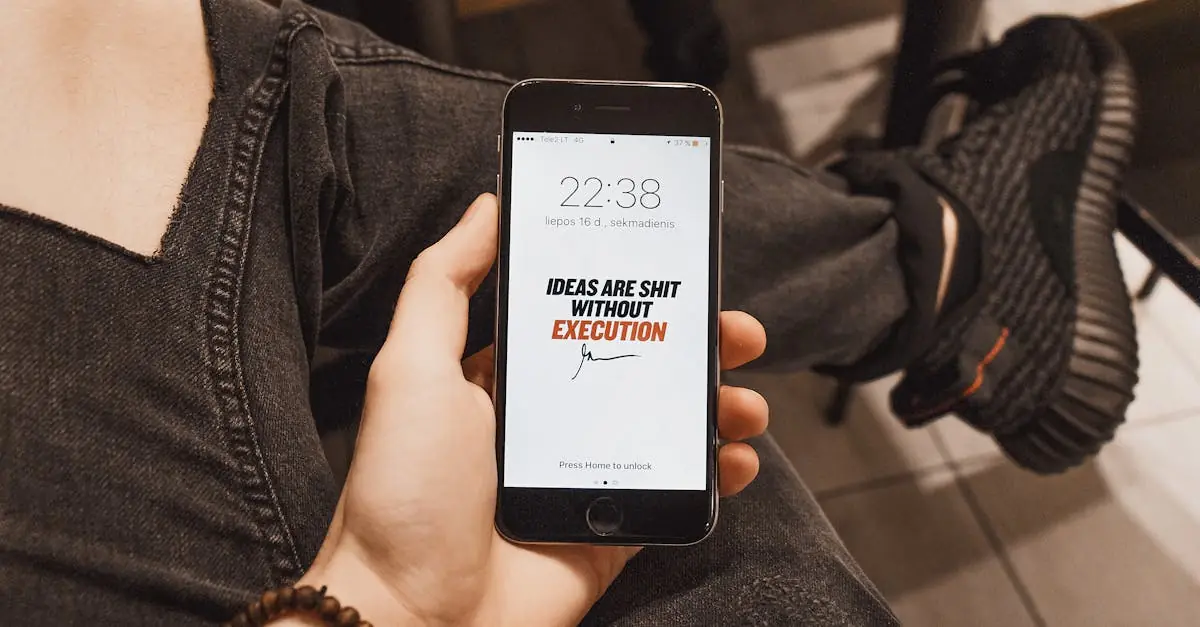Table of Contents
ToggleEver found yourself staring at a locked iPhone, feeling like it’s a high-tech fortress guarding your cherished memories? Don’t worry; you’re not alone. Many people have experienced the frustration of a locked device, but it’s not the end of the world. In fact, it might just be the beginning of a tech adventure!
Understanding a Locked iPhone
A locked iPhone restricts access to its content and features, which can be frustrating. Users face this situation if they forget their passcode or purchase a device that’s not unlocked. Security measures prevent unauthorized access, but they also pose challenges for rightful owners.
Resetting a locked iPhone offers a possible solution, albeit with some risks. Erasing the device results in losing all data not backed up. This process initiates in recovery mode, requiring users to connect the device to a computer and use iTunes or Finder.
In some instances, users can utilize Apple’s Find My iPhone feature. This option enables device tracking and potential unlocking if the correct Apple ID and password are available. Enabling this feature beforehand simplifies recovery.
Buying or selling a locked iPhone presents unique challenges. Many carriers enforce lock policies, preventing usage with different networks until conditions are met. Unlocking the device often requires contacting the original carrier for assistance or following their specific guidelines.
Heirs of locked iPhones may face additional hurdles. Verification of ownership through receipts or Apple ID credentials is crucial before any recovery efforts can commence.
While some third-party services claim to unlock devices, caution is necessary. Authorized service providers offer more reliable options with less risk than unverified sources. Always research and choose trusted methods when seeking assistance.
Common Issues with Locked iPhones
Locked iPhones present several common issues that frustrate users. Understanding these challenges can simplify the resolution process.
Reasons for Locking
Security measures primarily prompt locking. Users may forget their passcodes, leading to access issues. Purchasing a second-hand device often results in unexpected locks issued by the original carrier. User settings can also create a lock when activating features like Find My iPhone. Intentional locking serves as a theft prevention method. Entering incorrect passcodes multiple times triggers a temporary lockout too.
Types of Locks
Various types of locks exist on iPhones. The most common is the passcode lock, which secures personal data. Activation locks arise from Find My iPhone settings, preventing unauthorized use. Carrier locks restrict devices to specific networks, complicating switching carriers or selling. Restrictions on certain functions may also belong to parental controls, limiting device use for children. Each lock type requires different strategies for resolution.
Possible Solutions for Locked iPhones
Locked iPhones present several options for access restoration. Understanding these solutions can lead to effective device management and recovery.
Unlocking Methods
Several methods exist for unlocking a locked iPhone. Apple’s Find My iPhone feature helps users track and unlock devices if they remember their Apple ID and password. Resetting the device through iTunes or Finder also provides an alternative for users willing to erase all data. Third-party unlocking services claim to assist with bypassing locks, but it is crucial to exercise caution and prioritize authorized provider options. Successful recovery may also depend on carrier support in cases of network restrictions.
Using Recovery Mode
Using recovery mode stands out as a viable solution for locked iPhones. To initiate this process, connect the device to a computer with iTunes or Finder installed. Users must then force restart the device, approaching this differently depending on the iPhone model. Once in recovery mode, a prompt for restoring the device appears, leading to potential unlock success. Recovery mode erases all data, making prior backups essential for safeguarding information. Recognizing this method can yield fruitful results for those facing locked devices.
Accessing Limited Features
Locked iPhones still offer access to certain features that can assist in emergencies or provide limited functionality.
Emergency Features
Emergency calls can be made without unlocking the device by tapping the emergency call option on the lock screen. Users can reach emergency services by entering the appropriate numbers, even when the phone is locked. Health information may be accessible via the Medical ID feature if it’s set up beforehand. This feature allows first responders to view important medical data without entering a passcode. Additionally, the device may display a temporary ID if the user has chosen that option, providing crucial information in urgent situations.
Contacting Support
Contacting Apple Support can provide guidance for locked iPhones. The support team can assist in troubleshooting or guide users through unlocking processes. Users must be prepared to verify their identity and provide proof of ownership, such as the original purchase receipt. Reaching out to the carrier may also help with unlocking a phone that’s network restricted. Carriers often provide information on their unlocking policies and additional support. Utilizing these resources ensures that users receive necessary assistance efficiently, making the process less daunting.
Preventing Future Lockouts
Setting up preventive measures reduces the chances of future lockouts. Users can utilize biometric authentication features like Face ID or Touch ID for an added layer of security. Keeping the device’s software updated ensures that all security patches are applied, which helps prevent vulnerabilities. Regularly backing up data to iCloud or a computer protects important information in case of a lockout.
Creating memorable yet secure passwords plays a crucial role in avoiding forgotten passcodes. A password manager app can assist in generating and storing strong passwords safely. Users should also take the time to write down security questions and answers in a secure location. Authenticating with two-factor verification additionally strengthens account security.
Familiarizing oneself with the device’s settings facilitates smoother management in the future. Documentation of the Apple ID and password aids in accessing services tied to the account. Enabling the “Find My iPhone” feature proves beneficial, allowing users to locate devices quickly and reset passwords if needed.
In the event of purchasing a second-hand device, verifying its unlocking status before completion secures future access. Obtaining a receipt or proof of ownership from previous owners creates a clear path for unlocking services that may be necessary. Contacting the original carrier for any locked devices also offers solutions tailored to specific carrier policies.
Staying organized with account credentials and essential information eliminates confusion during emergencies. Bookmarking Apple’s official support page provides quick access to troubleshooting resources and guidelines tailored to various locks. Establishing a routine of periodically reviewing security settings contributes to maintaining optimal device security.
Dealing with a locked iPhone can be a frustrating experience but understanding the available options can make the process smoother. Whether it’s using Apple’s built-in features or seeking help from authorized service providers users can regain access to their devices. Preventive measures like enabling biometric authentication and regular backups can also minimize future lockouts.
For those navigating the complexities of locked devices it’s essential to stay informed about the different types of locks and the best strategies for resolution. With the right approach and resources at hand users can turn this challenge into an opportunity for greater device management and security.





